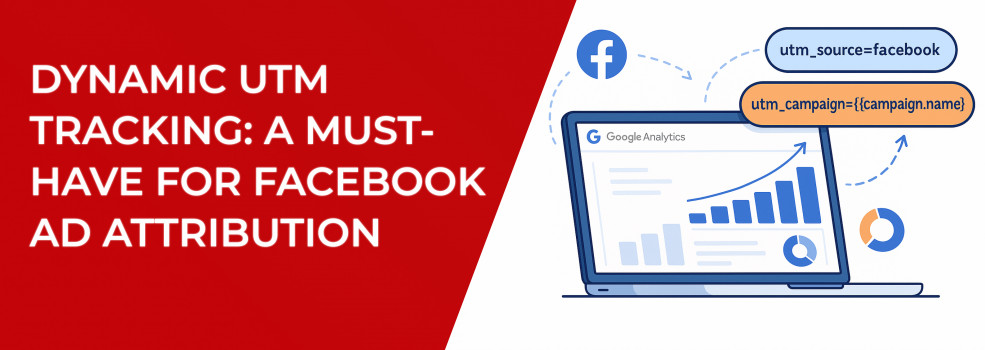If you have ever tried to answer the deceptively simple question “Which Facebook ad actually drove this sale?” you already know how slippery attribution can be. Between the average click through rate on Facebook ads, Meta’s in-platform reporting and the alphabet soup of web-analytics tools, getting a single source of truth feels impossible. Add iOS privacy prompts and impending cookie deprecation to the mix, and the data gap widens even more.
Dynamic UTM tracking closes that gap. By automatically appending rich, consistent parameters to every outgoing click, you unlock clean, first-party insights in Google Analytics 4, Looker Studio or any BI stack, no matter how often you tweak advantage campaign budget settings or pivot into a brand-new Meta ads campaign. Below you will learn why dynamic UTMs are non-negotiable for modern marketers, exactly how to set them up inside Meta, and what to measure once they are live.
Why “Good” Facebook Metrics Aren’t Good Enough
The next time you are tempted to Google “what is a good Facebook ad CTR” or scroll through a blog post titled “industry standard click-through rate,” remember that benchmarks can be useful but they rarely tell the whole story. Consider the following points, each of which puts public benchmarks into context.
Industry averages move every year, and the latest snapshot in What’s the Average Click-Through Rate for Facebook Ads in 2025? shows just how wide the range can be.
Before we dive into a short list, keep in mind that what follows is not a set of rigid rules. Instead, treat these ideas as a lens through which to view any number you see in Ads Manager or your analytics suite.
-
Context matters. A good Facebook ad CTR in ecommerce (often 1–2 percent) looks very different from B2B SaaS, where a lower click rate can still yield stellar ROAS benchmarks by industry.
-
Cost multiplies impact. A three-percent click-through is meaningless if your average cost per click Facebook figure has spiked forty percent week over week.
-
Platform gaps remain. Meta Ads Manager attributes conversions based on its own view-through window, while GA4 focuses on last non-direct click. Without extra tagging, comparing the two is guesswork.
Benchmarks are only half the picture; dynamic UTMs unlock revenue-level insights that matter.
If your ads still struggle to exit learning, this step-by-step guide on How to Finish the Facebook Learning Phase Quickly explains practical tweaks that accelerate delivery stability.
Taken together, these realities show that dynamic UTMs do not magically improve surface-level metrics, but they make sure every metric aligns across reports.
How Dynamic UTMs Work (and Why They Beat Manual Tags)
Manually adding UTMs is tedious and prone to error. Worse, parameters break the moment you duplicate, edit or automate ads at scale. Dynamic UTMs solve the problem by leveraging Meta’s built-in macros, which populate fields in real time:
utm_source=facebook
utm_medium=paid_social
utm_campaign={{campaign.name}}
utm_content={{ad.name}}
utm_term={{placement}}
Because each tag is generated at the moment of the click, you never have to wonder whether the Pixel measure you see in GA4 reflects the correct creative or placement. You can also splice in custom values, for example distinguishing retargeting pixels from prospecting clicks, which makes funnel segmentation straightforward later on.
Step-by-Step: Building Dynamic UTMs in Meta Ads Manager
Getting dynamic tagging live takes just a few minutes, yet many advertisers skip the step entirely. Follow the sequence below and you will never have to paste another tracking string by hand.
-
Open your ad set or ad. Under “Tracking,” toggle on URL Parameters.
-
Paste your dynamic template. Use the macro names exactly as Meta lists them, for example
{{adset.name}}. -
Preview the final URL. Meta shows you the rendered string so you can verify that nothing breaks.
-
Save as default. Every future campaign budget optimization build will inherit the template automatically.
After completing these steps, take a moment to send a test click through the ad preview tool. Confirm that the resulting session in GA4 carries the parameters you expect and that the landing page deep links properly on mobile devices.
For broader targeting fundamentals beyond tracking, see Facebook Ad Targeting 101: How to Reach the Right Audience.
What to Measure After Launch
Once dynamic UTMs are live, open your analytics suite and build a dashboard focused on the business outcomes that matter. The following table highlights three cornerstone metrics and explains where to locate each one.
Before you examine the grid, remind yourself that metrics become actionable only when viewed over time. Trend lines, not one-off snapshots, reveal whether a new Meta campaign or creative refresh is actually moving the needle.
After you have reviewed those numbers, add one or two qualitative notes summarizing what you see. For instance, if session-level ROAS rises when you allocate more spend to Reels placements, document the insight so the team can test similar creative in future sprints.
To expand your reporting repertoire, How to Analyze Facebook Ad Performance Beyond CTR and CPC walks through deeper metrics that pair perfectly with UTM data.
Common Pitfalls and Practical Fixes
Even seasoned marketers can misstep when rolling out dynamic tags. Spend a moment on each issue below so you can avoid hours of troubleshooting later.
-
Inconsistent naming conventions
Stick to lowercase, use hyphens instead of spaces and keep names short. Future searches for tracking ads on Facebook in GA4 will run smoothly when the taxonomy is tidy.
Mis-labelled ads often surface as warnings—review Understanding Facebook Ad Statuses: Common Issues and How to Fix Them for quick diagnostics. -
Forgetting deep links
Mobile users who install an app after clicking often drop UTMs. Implement on-site fallback URLs or SDK callbacks that pass parameters through the entire customer journey. -
Ignoring offline events
Feed point-of-sale data into Meta’s Conversions API to cover in-store purchases and maximize measurable Facebook conversion lift.
When conversion numbers still lag, the troubleshooting checklist in Facebook Ads Not Converting: How To Fix It can help uncover hidden blockers.
When these safeguards are in place, scaling campaigns becomes less risky because your attribution foundation is solid.
Final Thoughts
Dynamic UTM tracking is not just another analytics checkbox; it is the connective tissue that lets your data tell the same story everywhere. When your BI tool, CRM and Meta’s own Facebook advertising analytics all agree, you can act with confidence. You will retire underperformers faster, funnel spend into winning placements and raise budgets without losing clarity around attribution.
In a landscape where industry CTR benchmarks can shift overnight, reliable tagging is the difference between guessing and knowing. Embrace dynamic UTMs today and give every future optimization effort the accurate data it deserves.

